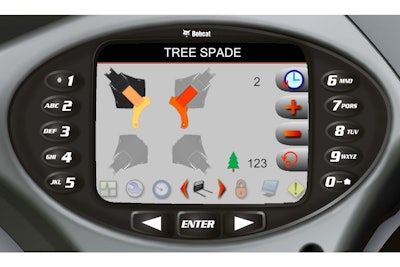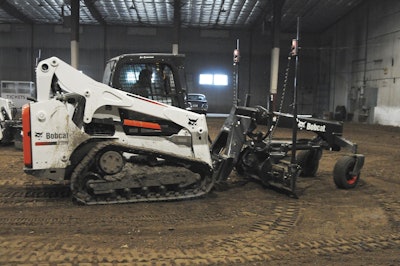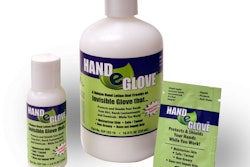
CANbus technology (CAN stands for controller-area network) was first developed by automotive engineers more than 20 years ago. It allows micro-controllers and devices to communicate with each other within a vehicle without the need for a host computer. CANbus technology opened up the possibility of using one wire to transmit and receive multiple messages.
Bobcat has integrated CANbus technology into its patented 7-pin attachment control kit, which is available on all except its smallest models. The 7-pin attachment control kit replaces the old 14-pin attachment control kit, which was used prior to 1999.
“The 14-pin attachment control kit is a traditional 12-volt power and ground system,” says Justin Odegaard, attachment product specialist with Bobcat. “As a result, for each attachment function, you need at least two power-positive type wires and, typically, a common ground. The 14-pin system and a less common 8-pin variant are used on most other makes of compact equipment.”
For example, Odegaard says, consider a dozer blade attachment with a cylinder that angles the blade left and right. The cylinder is controlled by an attachment control device containing several solenoids, including two that control the blade angle.
A wire runs from each solenoid to a switch on a handle in the loader cab. When the operator pushes the switch one way, it powers one wire, a solenoid opens, the cylinder retracts and the blade angles left. When the switch is pushed the other way, it powers the opposite wire, the solenoid closes, the cylinder extends and the blade angles right.
“It’s a simple system,” Odegaard says. “You’ve got wires that directly tie things together. Unfortunately, that’s all you’ve got. There’s no way to bring more information in or get more information out.”
Can we talk?
During the years, attachments grew more complex with numerous additional functions. In addition, there was a need to give machines and attachments the ability to talk to each. This led Bobcat Company to adopt CANbus technology and the 7-pin attachment control kit on most of its machines.
“With CANbus and the 7-pin system, we can send dozens of messages down the same wire harness and the attachment can understand what they are,” Odegaard says.
For example, he says, on the largest Bobcat tree-spade attachment there are four blades that go up and down, two gates that open and close and a pair of rear stabilizers. With the 7-pin system, all of that can be controlled with four switches, because one switch can be used to move a blade up and down and another to toggle between the four blades.
“That can’t be done with a 14-pin system,” Odegaard says.

But that’s not all. Because the attachment and the loader can communicate, the loader knows which attachment is connected to it, Odegaard says.
“One advantage to this is that the attachment can either activate or lock out the loader’s high-flow hydraulic system,” he says. “You just plug in the attachment and the machine recognizes that this is a high-flow attachment. The attachment then turns the high-flow hydraulics on so the operator doesn’t have to do it.” Conversely, he said, if an attachment is not high-flow compatible, it can lock out the machine’s high-flow hydraulics to prevent damage to itself.
Also, similar to the way the “check engine” light works on your car or light truck, the attachment can generate an error code to alert the operator that it has a problem.
Keeping it simple
The 7-pin attachment control kit also simplifies operation of Bobcat attachments that use a remote attachment control (RAC) system, Odegaard said. RAC attachments include the chipper, concrete pump, concrete mixer and a remote attachment control box that allows specified hydraulic hand tools to use the Bobcat machine as a power source.
RAC attachments use a box on the attachment that allows the operator to safely start and stop the machine and operate certain attachment functions from outside the cab of the machine. The RAC control box communicates with the machine to make sure certain parameters are met before the attachment will start the engine and allow operation.
“Before we introduced the 7-pin system, the 14-pin system wasn’t enough,” Odegaard said. “We actually had to use a 19-pin harness to be able to run the RAC attachments.”
In addition, with a 7-pin attachment connected to an M-Series Bobcat loader with the optional deluxe instrumentation panel, the operator can go to the attachments section and view additional information about the currently connected attachment.
This may include attachment hour meters and resettable job clocks that keep track of exactly how much time the attachment was used on the jobsite. Or, when operating a laser-guided box blade or grader attachment, the operator can see where the blade is relative to the target and can move the desired grade up or down from the comfort of the cab.
Odegaard noted that 14-pin Bobcat attachments can be used on current Bobcat machines if a 14-pin attachment control kit is installed on the loader. Likewise, a 7-pin attachment can be operated on a machine with a 14-pin attachment control kit by installing a 14-pin T-harness on the attachment. The T-harness bypasses the ACD and operates the attachment just as if it were a 14-pin attachment.
– Information provided by the Bobcat Company









